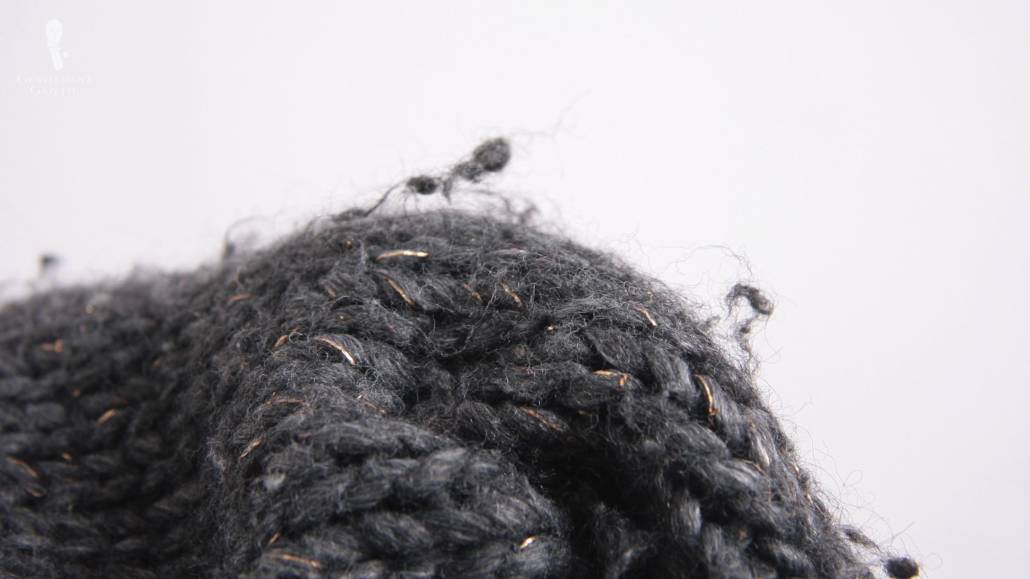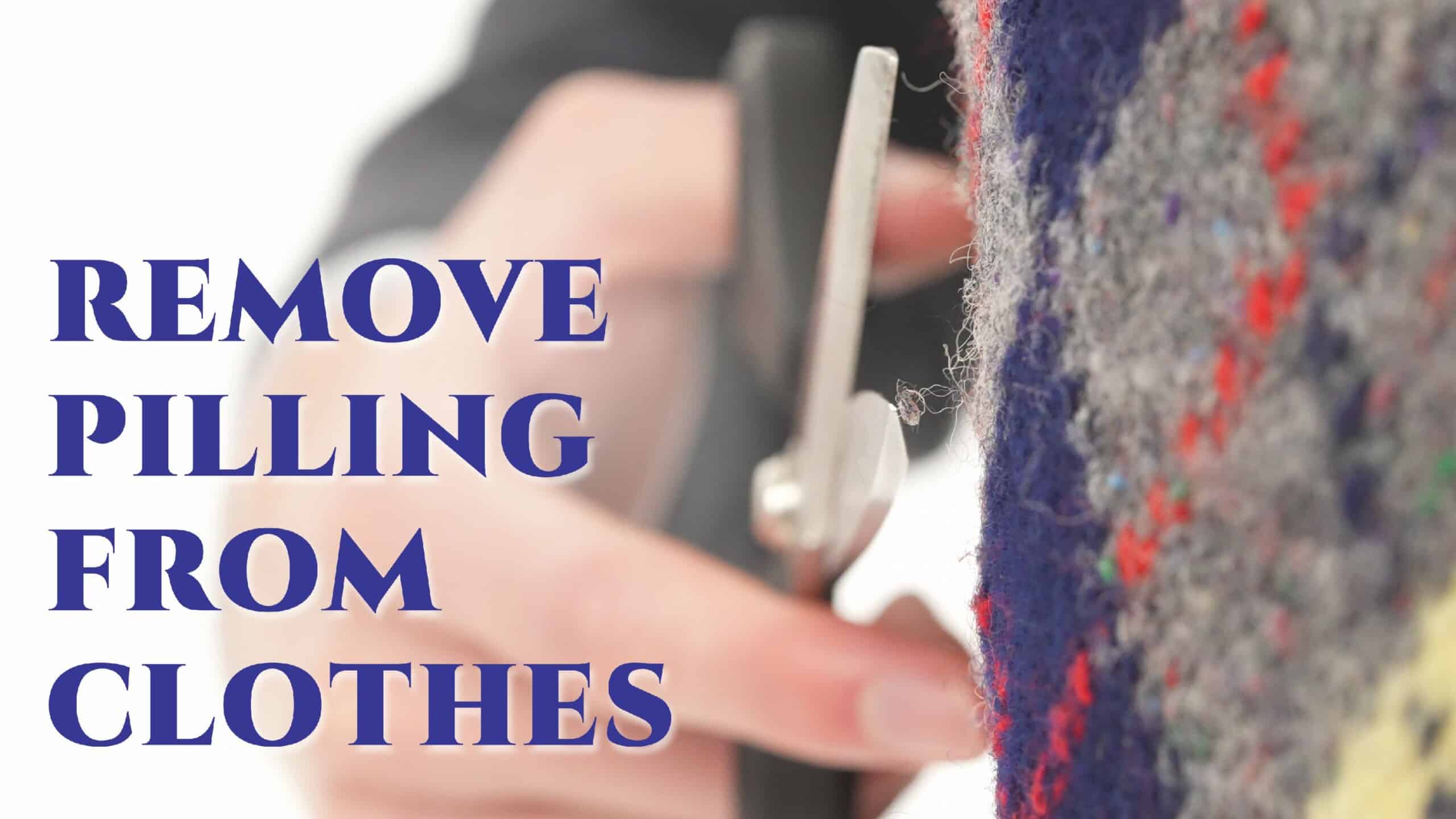As we’ve said numerous times, the true menswear aficionado seeks not only to build a robust wardrobe, but also to keep it well-maintained. This means using the proper laundering techniques, removing stains whenever they first occur…and removing those pesky little hangers-on that seem to find their way onto all different types of clothing: fabric pills!
What is Pilling?
A pill, sometimes known by other names, including a bobble, fuzzball, or lint ball, is a small ball of fibers that forms on a piece of cloth. It’s a surface defect of textiles caused by the washing and wearing of fabrics as loose fibers begin to push out from the surface of the cloth, and over time, abrasion causes the fibers to develop into small spherical bundles anchored to the surface of the fabric by fibers that haven’t yet broken fully.
A fun fact here: the textile industry officially divides the pilling process into four stages: fuzz formation, entanglement, growth, and wear-off.
Pilling normally happens on the parts of clothing that see the most wear and tear day-to-day, such as the collars and cuffs of shirts and sweaters, as well as under the arms, and around the thighs and the rear on trousers.

All fabrics do pill to some extent, but the primary causes of pilling are the physical characteristics of the textile, how it’s processed during manufacturing, the personal habits of the wearer, and the environment in which the garment is being worn.
Overall, natural fabrics are less likely to pill. These include things like silk, linen, hemp, and cashmere. Meanwhile, man-made fabrics are generally more likely to pill. These include things like polyester, acrylic, nylon, rayon, and spandex.
Also, depending on the weave, twist, and softness of the fibers, wool, and cotton can go either way in terms of pilling. You have to take garments using those on a case-by-case basis. Note also that wool pilling generally diminishes over time as more wool fibers work themselves free of the fabric and break away, whereas stronger synthetic fibers will hold on to pills preventing them from falling off of the garments.

In general, longer fibers are going to pill less than short ones–partly because there are fewer loose ends to the fibers and partly because being longer, it will take more time and effort for those fibers to work themselves out of the weave. This is also related to the idea of “twist.” In other words, the higher the twist, the denser the yarns are going to be and the firmer they’re going to feel to the hand.
As you might imagine, fabrics with a large number of loose fibers are going to be more likely to pill. When a fabric is made of a blend of fibers both weak and strong (think of something, for example, that blends natural and synthetic fibers), the weaker fibers are going to break, work their way out, and bundle up, but the stronger fibers are going to hold those weak ones on. Therefore, blended fabrics are going to be even more likely to pill overall.

Keep in mind that pilling doesn’t generally interfere with the functionality or wearability of a textile or garment–unless of course an area of excessive pilling eventually causes a hole in the fabric. But with that said, pills are definitely a nuisance and they can certainly be quite unattractive, so you’re better off dealing with them properly.
How to Handle Pilling – Part 1: Pill Prevention
Fortunately, there are a number of different strategies that you can use to prevent your clothing from pilling in the first place.
Buying Advice
First of all, as we alluded to before, try to find and buy garments that have higher-density, more finely twisted yarns that are going to be more durable. As we also mentioned, fabrics that are made from blends of natural and synthetic fibers are going to be more likely to pill.

Always remember to check labels and tags before purchasing and, as a general piece of advice, try to avoid garments that have three or more different kinds of fibers in the weave.
Laundry Techniques
Next, let’s cover some laundry day strategies you can use to prevent pilling when you’re washing your clothes. First, keep in mind that when you’re washing, any pills that are present on a garment can agitate other clothing fibers causing more loose ends and more pilling overall; it’s something of a “snowball effect.” With that in mind, here’s our list of washing advice.
- First, for garments that you suspect are going to pill, consider using your washing machine’s gentle cycle. The lesser degree of agitation and shorter wash cycle should prevent more pills from forming. You could also consider using mesh garment bags for such garments when they’re in the washing machine, or hand washing, which is going to be even more gentle.



General Wear & Tear Tips
Moving on from the laundry room, our final prevention tips today refer just to the general wear and tear of your garments.
First, try to rest your garments in-between wears, as excessive and repeated wearing can cause more pilling. When you wear an article of clothing, the fibers tend to stretch a bit, which can cause some of the shorter, looser threads to come loose more and, thus, begin pilling. As a general guideline, try to give a garment at least 24 hours in between wears to give it time to rest.

Next, don’t carry backpacks. Anywhere that a backpack has prolonged contact with your clothes or your body, such as your shoulders and back, is going to be a site of an increased likelihood of pilling. Of course, backpacks are also an item that we would encourage stylish men to avoid for other reasons in our guide to 19 Things Men Should Never Wear. A briefcase or attache case would be a better and more stylish choice.
Finally here, just try to limit the amount of everyday friction and abrasion that your clothes experience from things like resting your elbows on tables or sitting on rough surfaces.
Part 2: Pill Removal
Sweater Comb or Razor
Fortunately, there are several tools available for removing pills from your clothing, and perhaps, the safest bet among these is a sweater comb. To use the sweater comb, place your garment on a hard flat surface, pull it taut with your free hand, and run the comb slowly but firmly across the fabric at a slight angle. You can increase your speed as you feel comfortable, but be sure not to abrade the fabric.

Also, you should periodically clean off the teeth of the sweater comb as you work. This same technique can be employed with a cheap disposable razor, although you should exercise more care, and, of course, avoid using razors that have gel comfort strips or anything like that.
Stones
Other tools with which you can use this same method include a sweater stone, as well as a more typical pumice stone, although the latter will be rougher and should be used with more care. Some sources will advocate for the use of things like sandpaper sponges or Velcro, but we believe that these types of tools are generally going to cause excess abrasion to your garments.

Scissors
An alternative method involves pulling your garment taut over a slightly curved surface and using a pair of small sharp scissors to cut off the pills. This can work, but exercise caution as you obviously don’t want to cut open a hole. A more precise option would be to use something like a cuticle clipper, like the ones that are included in our Fort Belvedere manicure kits.

Electric Pill Remover
Finally, you could also consider using a battery-powered or electric fuzz and pill remover that shaves the pills off of the fabric. This is generally going to be a safe option, but we would advise against using them on knits or particularly loose weaves, and if you do use one, again, exercise caution.

No matter what tool you choose to get the job done, once you’re finished de-pilling your garment, brush it off with a garment brush. Don’t use a conventional lint roller or other adhesives that are advocated online, like tape, as these are going to pull out more loose fibers, essentially starting the pilling process all over again.
Conclusion
So, that’s the low-down on why pilling happens, and how you can prevent it and remove pills from your clothing. Hopefully, when you see these little fuzz balls, it won’t be such a hard pill to swallow in the future!


My wife loans me her garment shaver. I have used it on on old favourite overcoat. It works well. I have also used it gently on a jumper. It also did the job.
That’s great! Thanks for sharing, Keith! :)
Is there a specific sweater comb you recommend?
Hi Dale! The comb used in the video was from The Laundress if that helps. :) https://www.thelaundress.com/sweater-comb.html
Some jackets have labels inside, which have “sharp” edges and over time the abrasion results in piling of woven garments. Best is to cut these carefully out right away… The same can happen with zippers, velcro or other damaging items on outerwear and in these cases it is wiser to add a layer to protect the knitwear.
Not long ago I saw a pullover in a store with a label attached, which was explaining, that it will pill and that is the sign of high quality!! Of course that is utter nonsense: If the yarn is of high quality, and the fibers are long, it will pill much less than a cheap pullover or not at all. I have some Irish knitwear from 30+ years ago, which did not pill yet… Regrettably by now this quality is impossible to find.
Good point. Thanks for sharing, Mike!